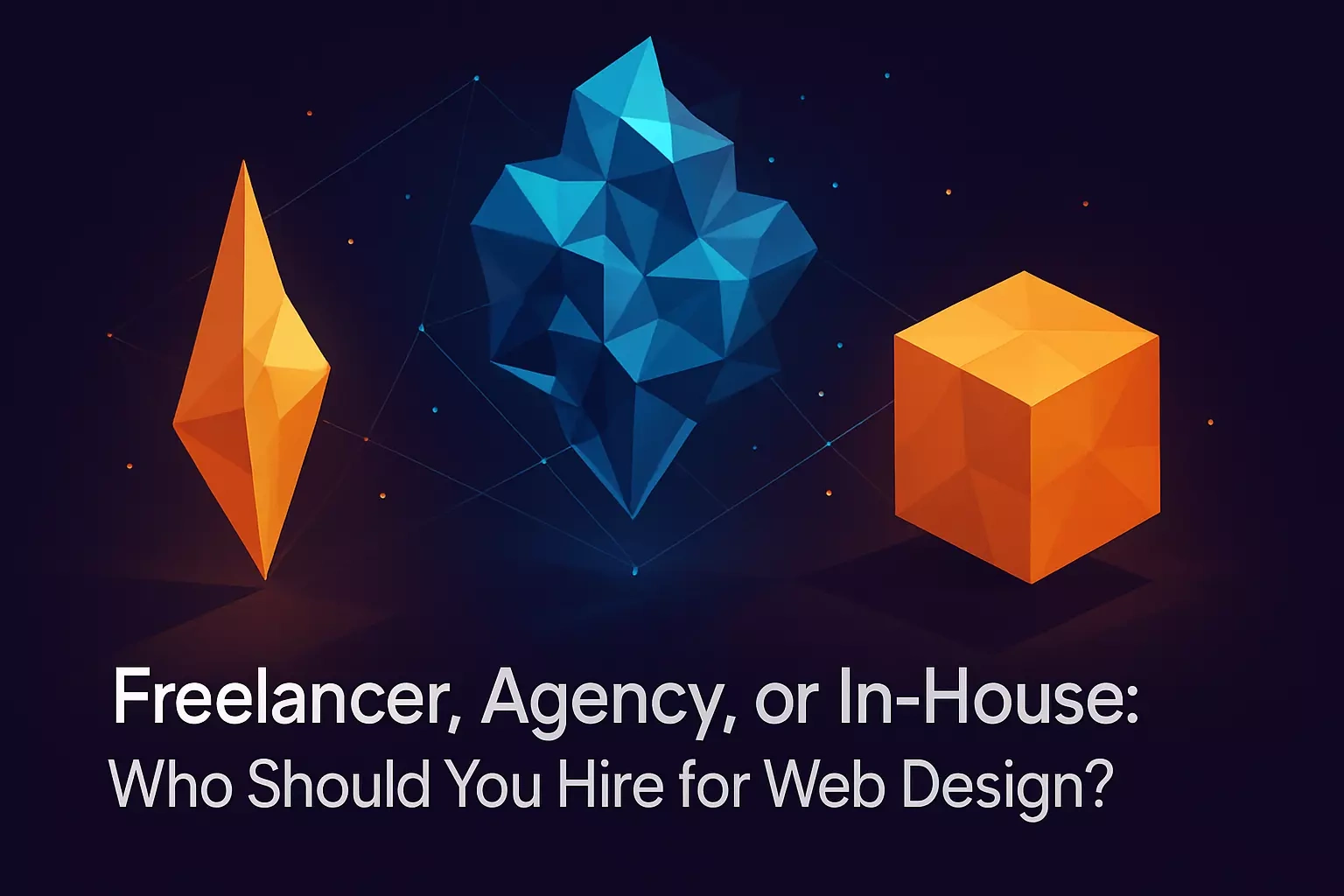Freelancer, Agency, or In-House: Who Should You Hire for Web Design?

Freelancer, Agency, or In-House: Who Should You Hire for Web Design?
Hiring a Freelance Web Designer
Pros of Hiring a Freelancer
Cons of Hiring a Freelancer
Partnering with a Web Design Agency
Pros of Hiring an Agency
Cons of Hiring an Agency
Building an In-House Web Design Team
Pros of an In-house Team
Cons of an In-house Team
How to Make the Right Choice
Assess Your Project Scope and Budget
Consider Your Long-Term Needs
Making Your Final Decision
Conclusion
References
Freelancer, Agency, or In-House: Who Should You Hire for Web Design?
Once you've decided on the scope of your web project and understand whether you need a designer, a developer, or both, the next big question is who to hire. This decision often comes down to three main options: a freelance web designer, a web design agency, or an in-house hire. Each path offers unique advantages and disadvantages in terms of cost, expertise, and flexibility.
Making the right choice depends on your budget, project complexity, and long-term goals. Before diving in, it's helpful to know if you're building from a template or need a completely custom design, as this will influence your hiring decision.
Let's break down each option to help you make the best choice for your business.
Hiring a Freelance Web Designer
Freelancers are independent professionals who work on a project or contract basis. This option has become increasingly popular, especially for small to medium-sized businesses looking for quality work without breaking the bank.
Think of freelancers as skilled specialists you can tap into when needed. They run their own businesses, manage their own schedules, and often work with multiple clients simultaneously. This independence can work in your favor—or against it—depending on your specific needs.
Pros of Hiring a Freelancer
The biggest draw for most businesses is cost-effectiveness. Freelancers typically charge 30-50% less than agencies for similar work. Why? They don't have the overhead costs of office space, employee benefits, or administrative staff. These savings get passed directly to you.
Direct communication is another major advantage. When you hire a freelancer, you're talking straight to the person doing the work. No middlemen, no account managers, no game of telephone. You explain what you want, they ask clarifying questions, and boom—work begins. This streamlined communication often leads to faster turnaround times and fewer misunderstandings.
Flexibility is where freelancers really shine. Need someone who can work odd hours to accommodate your schedule? A freelancer can do that. Want to start small with a landing page before committing to a full website? Perfect for a freelancer. They can adapt to your timeline and scale their involvement based on your needs.
Many freelancers also bring specialized expertise to the table. Since they often focus on specific niches or industries, you might find someone who's designed dozens of websites for businesses just like yours. This targeted experience can be invaluable.
Cons of Hiring a Freelancer
Here's the reality check: one person can only do so much. Even the most talented freelancer has limitations. While they might excel at visual design, they could lack skills in areas like advanced programming, SEO optimization, or copywriting. This means you might need to hire additional freelancers to fill these gaps, which can complicate project management.
Bandwidth becomes a real issue with larger projects. A freelancer juggling multiple clients might not have the capacity to handle your complex e-commerce site redesign within your aggressive timeline. And if they get sick or take a vacation? Your project could stall completely.
The availability factor is worth serious consideration. Good freelancers are often booked weeks or months in advance. If you need urgent changes or encounter problems after launch, your freelancer might be deep into another client's project. This can leave you in a tough spot when time is critical.
There's also the risk factor. If a freelancer disappears mid-project (it happens more than you'd think), you're left scrambling. Without a team backup or formal business structure, you have limited recourse beyond finding someone new and potentially starting over.
Partnering with a Web Design Agency
A web design agency is essentially a full-service team under one roof. These companies employ designers, developers, project managers, and often specialists in areas like SEO, content creation, and digital marketing. Think of them as your web design department for hire.
Agencies operate with established processes, formal contracts, and structured timelines. They're built to handle everything from simple brochure sites to complex digital platforms.
Pros of Hiring an Agency
The comprehensive skill set is what sets agencies apart. When you hire an agency, you're not just getting a designer—you're getting an entire team. The designer creates the visuals, the developer brings them to life, the SEO specialist ensures you'll be found online, and the project manager keeps everything running smoothly. It's like having a mini web department at your disposal.
Agencies excel at handling complex, multi-faceted projects. Need a website with custom functionality, integrated e-commerce, and a content management system? An agency has done it before. They have established workflows and quality control processes that help prevent costly mistakes and ensure consistent results.
Long-term support is another significant advantage. Agencies don't just build your site and disappear. They offer maintenance packages, can handle updates, and are there when things go wrong. This ongoing relationship means they understand your business deeply and can provide strategic advice as you grow.
The scalability factor is huge. As your business expands, an agency can scale their services to match. Need to add new features? Launch a mobile app? Create a sister site? They have the resources to grow with you without missing a beat.
Cons of Hiring an Agency
Let's address the elephant in the room: cost. Agencies are expensive—often 2-3 times more than freelancers for similar projects. You're paying for their expertise, sure, but also their office rent, employee benefits, and profit margins. For small businesses or startups, this can be prohibitive.
Communication can feel less personal with agencies. Instead of talking directly to your designer, you might go through an account manager who relays information to the team. This can sometimes feel like a game of telephone, where your original vision gets slightly distorted with each handoff.
Agencies often have more rigid processes. While structure can be good, it can also mean less flexibility. Want to make a quick change? It might need to go through their formal revision process. Need something done outside normal business hours? That might not be possible without additional fees.
Some businesses also find that agencies can feel less invested in their individual success. When you're one of dozens of clients, you might not get the same personal attention and passion that a freelancer brings to their select projects.
Building an In-House Web Design Team
Hiring in-house means bringing web design talent onto your payroll as full-time employees. This option represents the biggest commitment but can offer the most control and integration with your business.
An in-house team becomes part of your company culture, attends your meetings, and lives and breathes your brand every day. For businesses with ongoing web design needs, this deep integration can be invaluable.
Pros of an In-house Team
The dedication factor is unmatched. Your in-house designer isn't juggling other clients or checking the clock. They're 100% focused on your business, understanding your goals, and working toward your success. This dedication often translates into better results and more innovative solutions.
Deep brand knowledge develops naturally over time. An in-house team doesn't need lengthy onboarding for each project—they already know your brand guidelines, target audience, and business objectives inside and out. This institutional knowledge speeds up project timelines and ensures consistency across all digital properties.
Immediate availability is a game-changer. Need a quick update? Your designer is right down the hall. Spotted a typo? Fixed within minutes. This instant access is particularly valuable for businesses that need to move fast or make frequent updates.
The collaboration potential is enormous. Your web team can sit in on marketing meetings, coordinate with sales, and align with other departments in real-time. This cross-functional collaboration often leads to more cohesive strategies and better overall results.
Cons of an In-house Team
The financial commitment is substantial. Beyond salary (which for skilled designers can range from $60,000 to $100,000+), you're looking at benefits, equipment, software licenses, training, and other employment costs. The total cost often surprises businesses new to hiring in-house talent.
Finding the right talent can be a lengthy, frustrating process. Good web designers are in high demand, and convincing them to join your team instead of staying freelance or joining an established agency can be challenging. The hiring process might take months, during which your projects remain on hold.
Skill gaps become your problem to solve. A single designer rarely possesses all the skills needed for modern web design—visual design, UX, front-end development, back-end programming, SEO, and more. You'll likely need to hire multiple people or invest heavily in training.
The perspective limitation is real. In-house teams can develop tunnel vision, recycling the same ideas and approaches. Without exposure to diverse clients and industries, they might miss innovative solutions that an agency or freelancer would bring from their varied experience.
How to Make the Right Choice
So how do you decide? The answer isn't one-size-fits-all. The best choice depends on your specific situation, goals, and resources. Let's walk through the key factors to consider.
Start by being brutally honest about your needs. A simple five-page website? A freelancer can handle that beautifully. A complex platform with user accounts, payment processing, and custom features? You'll want the robust capabilities of an agency. Ongoing design needs with frequent updates? In-house might make the most sense.
Assess Your Project Scope and Budget
Begin with a clear project definition. Write down exactly what you need: number of pages, special features, timeline, and any technical requirements. This clarity helps you communicate with potential hires and get accurate quotes.
Budget considerations go beyond the initial cost. Factor in:
Initial design and development
Ongoing maintenance and updates
Potential scope changes
Emergency fixes
Future enhancements
A freelancer might quote $5,000 for your project, while an agency quotes $15,000. But if the freelancer can't handle the technical complexity and you need to hire additional help, the costs can quickly equalize.
Consider the hidden costs too. With freelancers, you'll spend more time on project management. With agencies, you might pay for services you don't need. With in-house hires, you'll have ongoing costs even during slow periods.
Timeline flexibility matters. Freelancers can often start quickly but might have limited availability. Agencies have more resources but might have longer lead times. In-house hiring could take months before work begins.
Consider Your Long-Term Needs
Think beyond the initial launch. Websites aren't "set it and forget it" anymore. They need regular updates, security patches, content changes, and eventual redesigns. Who will handle this ongoing work?
If you anticipate regular changes and updates, the availability of your web partner becomes crucial. A freelancer who was perfect for the initial build might not have capacity for ongoing maintenance. An agency's retainer might seem expensive until you need those emergency fixes.
Consider your growth trajectory. If you're planning to expand significantly, will your web partner be able to scale with you? A solo freelancer might struggle to keep up with a rapidly growing business, while an agency or in-house team can expand their capacity.
The relationship factor shouldn't be overlooked. Web design is often an ongoing partnership, not a one-time transaction. Consider which option offers the relationship style that works for your business. Some prefer the personal touch of a freelancer, while others value the professionalism and structure of an agency.
Making Your Final Decision
Here's a practical framework for making your choice:
Choose a freelancer when:
Your budget is limited (under $10,000)
Your project is well-defined and relatively simple
You need specialized expertise for a specific task
You value direct communication and flexibility
You're comfortable managing the project yourself
Choose an agency when:
You have a complex project requiring multiple skill sets
Your budget can accommodate higher costs ($15,000+)
You want comprehensive services and ongoing support
You prefer structured processes and project management
You need scalability for future growth
Choose in-house when:
You have continuous web design needs
You can afford the ongoing costs of employment
You want complete control and immediate availability
Your web presence is critical to your business
You're building for the long term
Remember, these aren't mutually exclusive options. Many successful businesses use a hybrid approach—perhaps an in-house designer for day-to-day needs with agency support for major projects, or a primary freelancer supplemented by specialists as needed.
The key is starting with clarity about your needs, being realistic about your resources, and choosing the option that best aligns with your business goals. Don't just focus on cost—consider value, reliability, and the quality of the partnership you're building.
Conclusion
Choosing between a freelancer, agency, or in-house team for your web design needs isn't just about comparing prices. It's about finding the right fit for your project scope, budget, timeline, and long-term goals.
Freelancers offer affordability and flexibility but may lack the comprehensive skills and availability for complex projects. Agencies provide full-service solutions and scalability but come with higher costs and potentially less personal attention. In-house teams deliver dedication and deep brand knowledge but require significant investment and time to build.
Take time to assess your specific needs. Define your project clearly, consider your long-term requirements, and be honest about your budget and management capabilities. The right choice is the one that aligns with where your business is now and where you want it to go.
Ready to move forward? Start by creating a detailed project brief. This will help you communicate effectively with potential partners and make an informed decision. Whether you choose a freelancer, agency, or in-house team, clear communication and realistic expectations are the foundation of a successful web design project.
References
Like this project
Posted Jun 30, 2025
Choosing the right web design partner is crucial. Compare the pros and cons of hiring a freelance web designer, a design agency, or an in-house team to find the best fit.










